by H.S. Arathi, D. Davidson and L. Mason* (11/17)
Quick Facts…
- There are over 20,000 bees species found worldwide.
- There are 946 native bee species in Colorado.
- Most native bees are solitary and nest underground or in drying/dead plant stalks.
- Studies have shown that native plants are four times more attractive to native bees than introduced ornamentals.
Of all the pollinators found in gardens, agricultural fields and natural areas, bees are the most common and efficient. There are over 20,000 bee species found throughout the world. Of the approximately 4,000 native species known to occur in the United States, 946 are found in Colorado. They vary greatly in size, shape and color (Fig. 1, 2). In fact, there is a good chance that you have seen a native bee, but didn’t realize that it was a bee because they can look so different than the more familiar honey bee.
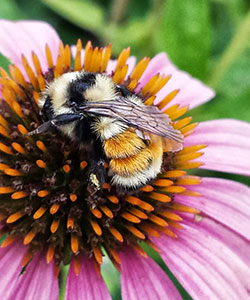 Figure 1: Bumble bee, Bombus sp. Photo by Micaela Truslove |
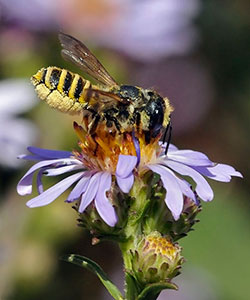 Figure 2: Leaf-cutting bee, Megachile fidelis. Photo by Richard Greene |
 Figure 3: Honey bee, Apis mellifera. Photo by Lisa Mason |
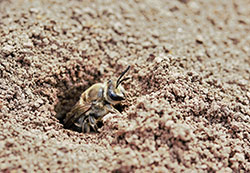 Figure 4: Bee emerging from soil. Photo by MaLisa Spring |
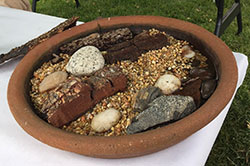 Figure 5: Bee watering dish |
The well-known honey bee (Fig. 3) is native to Europe and was introduced into the US by European settlers in the 1600s. They have been a part of the American landscape ever since. While honey bees sting as a means of protecting their offspring and honey in their hive, it is important to note that most of the native species in Colorado are simply not inclined to sting or do not have enough venom for a painful sting, even if they try.
Habitat Needs for Native Bees
Just like humans and other animals, bees and other pollinators need food, water, shelter and space to support robust populations. Pollinator habitat is an area with a variety of flowering plants that provide food and nesting space (see Fact Sheet 5.616 for more information).
Unlike honey bees that are social and live in large colonies, 90% of native bee species found around the world are solitary. Approximately 70% of these nest underground in the soil (Fig. 4), and about 30% nest inside hollow stems of plants and in tunnels left by other insects. When creating habitat for these solitary species it is important to take this into account. You can provide snags (dead wood) and areas of sunny, undisturbed, unmulched ground in your garden to allow for the native bees to create spaces for their nests. You should avoid using landscape fabric in the habitat area as it would impede the ability of ground-nesting bees to tunnel into the soil.
When considering shelter and vegetation for native bees, it is best to plant in layers, replicating nature. Begin by establishing a basic structure as the first layer with trees and shrubs. Then add perennials, grasses, and groundcovers as further layers within the landscape. Bees, of course, need water too. You can provide a shallow dish filled with pebbles and water to allow bees and other insects to get a drink (Fig. 5).
The pebbles allow for an easy landing and an easy exit. Be sure to drain and refill the dish every few days to avoid harboring mosquito larvae. Bees will also drink water from common landscape irrigation sources like drip systems and sprinkler heads. It is important to avoid spraying chemicals near any source of water such as bird baths or fountains, to avoid poisoning bees.
Plant List for Foraging Bees
The list of plants for pollinator habitats will vary for different parts of Colorado as climatic conditions, soil quality, elevation and water availability are highly variable. It is important to have plants that bloom from early spring through summer and as late into the fall as possible to provide continual resources for pollinators. A Xerces Society study shows that native plants are four times more attractive to native bee species than introduced ornamentals which makes sense because they would have co-evolved together.
Here are some suitable native plants that are grouped based on the flowering season to get you started. Please see Fact Sheet 5.616 for a more complete list.
Early-Season
- Blue Flax – Linum lewisii
- Pasque flower – Pulsatilla patens
Mid-Season
- Asters (many options available, check with local nursery
- Yarrow – Achillea millefolium
- Flowering trees including willows and black locust
Late-Season
- Rocky Mountain bee plant – Cleome serrulata
- Common sunflower – Helianthus annuus
- Goldenrod – Solidago spp.
- Late season flowering shrubs
- Rabbitbrush – Chrysothamnus nauseosus
Incorporating Nesting Habitat into Your Home Garden
Many people are familiar with the managed (or domesticated) honey bee and the large colonies they create. In a single honey bee hive there is one queen that does all the egg laying and tens of thousands of workers that are building cells, cleaning the hive and foraging for pollen and nectar.
In the case of native bees (Fig. 6), each female builds her own nest. The female excavates nesting material (whether in a hollow stem or underground), makes a cell, gathers pollen and rolls it into a pollen ball, lays an egg on the pollen ball and then seals off the cell. She then builds another cell, gathers more pollen and lays an egg on the pollen ball and so on (Fig. 7). This building and egg laying begins in the spring and continues through the season. At the end of the season the female dies. The eggs she has laid hatch, the larvae feed on the pollen ball and overwinter as pupae. The adult emerges next spring and whole cycle repeats.
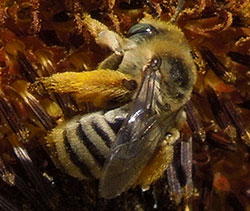 Figure 6: Digger bee, Anthophora Photo by Lisa Mason |
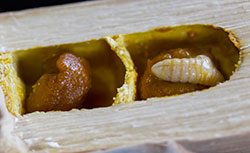 Figure 7: Pollen ball Photo by MaLisa Spring |
Nesting materials for native bee species include natural material such as dead wood, drying plant stems and exposed ground that is not mulched. Dead tree stumps can be left in the yard adding a landscape element while encouraging wood boring bees to nest. Avoid pruning perennials and cane fruits like raspberries during fall. Instead, leave dry stems behind providing stem nesting bees a location to overwinter and add winter interest for your garden. Prune stems back during late spring when adults have emerged from the stems. You can also recycle any extra sod into a ‘bee bank’ for ground nesting bees. Allow sod to sit upside down (dirt side up) in the sun. Once the grass is dead, bees will use the dried sod for nesting. Planting flowering plants on the top and along the sides of the sod bank will attract mining and digging bees that will nest in the sod and forage on the plants nearby.
You can also create nesting materials. Nest boxes, untreated 4″ x 4″ or larger wood with holes of different sizes drilled into it, can also be set up. Several bee species will nest in these wooden boxes. Make sure holes are smooth and do not quite go all the way through the piece of wood. Place the nest boxes in an open, but protected spot that receives plenty of early morning sun which helps bees warm to flying temperatures (Fig. 8).
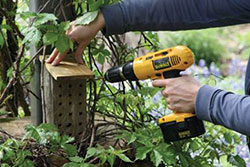 Figure 8: Nesting box |
Nest boxes can also be built as a group of bamboo canes of varying sizes tied together in a box. The hollow bamboo stems provide nesting holes for a wide range of native bee species. Clay bee homes are also common handmade nesting homes that mimic holes in the earth. With any of these options, you will be able to observe bees flying in and out of the holes and eventually sealing up the ends with mud, sand and small gravel or bits and pieces of leaves and grass.
Native bees are the unsung heroes of the pollination world. While there are numerous species of pollinators, because of their solitary nature, native bees can easily go unnoticed. Learning more about them and providing valuable habitat for them will help sustain these important pollinator species.
Reference
Creating Pollinator Habitat, Colorado State University Extension Fact Sheet #5.616.
*H.S. Arathi (Arathi Seshadri), Department of Soil and Crop Sciences, D. Davidson: CSU Extension, Boulder County, L. Mason: Bioagricultural Sciences and Pest Management Department, 11/2017.





